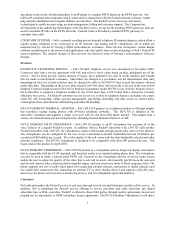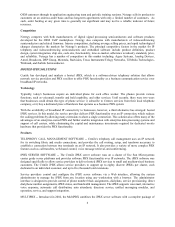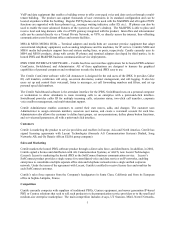8x8 2003 Annual Report Download - page 16
Download and view the complete annual report
Please find page 16 of the 2003 8x8 annual report below. You can navigate through the pages in the report by either clicking on the pages listed below, or by using the keyword search tool below to find specific information within the annual report.13
The Company has two primary subsidiaries, Netergy Microelectronics, Inc. (Netergy) and Centile, Inc. (Centile).
Netergy provides voice and video semiconductors and related communication software to original equipment
manufacturers, or OEMs, of telephones, terminal adapters, and other endpoint communication devices and to other
semiconductor companies. Netergy's technologies are used to make IP telephones and to voice-enable cable and
digital subscriber line, or DSL, modems, wireless devices, and other broadband technologies. Centile develops and
markets hosted iPBX solutions that allow service providers to offer to small and medium-sized businesses over
broadband networks the features and functions that are commonly found in a typical business phone system. A
hosted iPBX solution is a software application that implements the functionality of a business phone system over the
same data connection that a business uses for connection to the internet. The phone system software runs on servers
that are located at a central data center so that the only phone system equipment that is required at the customer site
are telephones. The phone system can also be accessed and controlled from any web browser on the internet.
CRITICAL ACCOUNTING POLICIES
Our consolidated financial statements are prepared in conformity with accounting principles generally accepted in
the United States. Note 1 to the consolidated financial statements in Part II, Item 8 of this Report describes the
significant accounting policies and methods used in the preparation of our consolidated financial statements.
We have identified the policies below as some of the more critical to our business and the understanding of our
results of operations. These policies may involve a higher degree of judgment and complexity in their application
and represent the critical accounting policies used in the preparation of our financial statements.. Although we
believe our judgments and estimates are appropriate and correct, actual future results may differ from our estimates.
If different assumptions or conditions were to prevail, the results could be materially different from our reported
results. The impact and any associated risks related to these policies on our business operations is discussed
throughout Management's Discussion and Analysis of Financial Condition and Results of Operations where such
policies affect our reported and expected financial results.
Use of estimates
The preparation of our consolidated financial statements, in conformity with accounting principles generally
accepted in the United States, requires management to make estimates and assumptions that affect the reported
amounts of assets, liabilities and equity and disclosure of contingent assets and liabilities at the date of the financial
statements and the reported amounts of revenues and expenses during the reporting period. These estimates,
particularly estimates relating to litigation and other contingencies, have a material impact on our financial
statements, and are discussed in detail throughout our analysis of the results of operations.
In addition to evaluating estimates relating to the items discussed above, we also consider other estimates, including,
but not limited to, those related to bad debts, the valuation of inventories, goodwill, income taxes, and financing
operations. We base our estimates on historical experience and on various other assumptions that are believed to be
reasonable under the circumstances, the results of which form the basis for making judgments about the carrying
value of assets, liabilities and equity that are not readily apparent from other sources. Actual results could differ
from those estimates under different assumptions or conditions. Additional information regarding risk factors that
may impact our estimates is included below under "Factors that May Affect Future Results."
Revenue recognition
Our revenue recognition policies are described in Note 1 to the consolidated financial statements in Part II, Item 8 of
this Report. As described below, significant management judgments and estimates must be made and used in
connection with the revenue recognized in any accounting period. Material differences may result in the amount and
timing of our revenue for any period if our management made different judgments or utilized different estimates.
At the time of each revenue transaction we assess whether the revenue amount is fixed and determinable and
whether or not collection is reasonably assured. We assess whether the fee is fixed and determinable based on the
payment terms associated with the transaction. If a significant portion of a fee is due after our normal payment
terms, which are thirty to ninety days from invoice date, we account for the fee as not being fixed and determinable.
In these cases, we recognize revenue as the fees become due. We assess collection based on a number of factors,
including past transaction history with the customer and the credit-worthiness of the customer. We generally do not
request collateral from our customers. If we determine that collection of a fee is not reasonably assured, we defer the
























